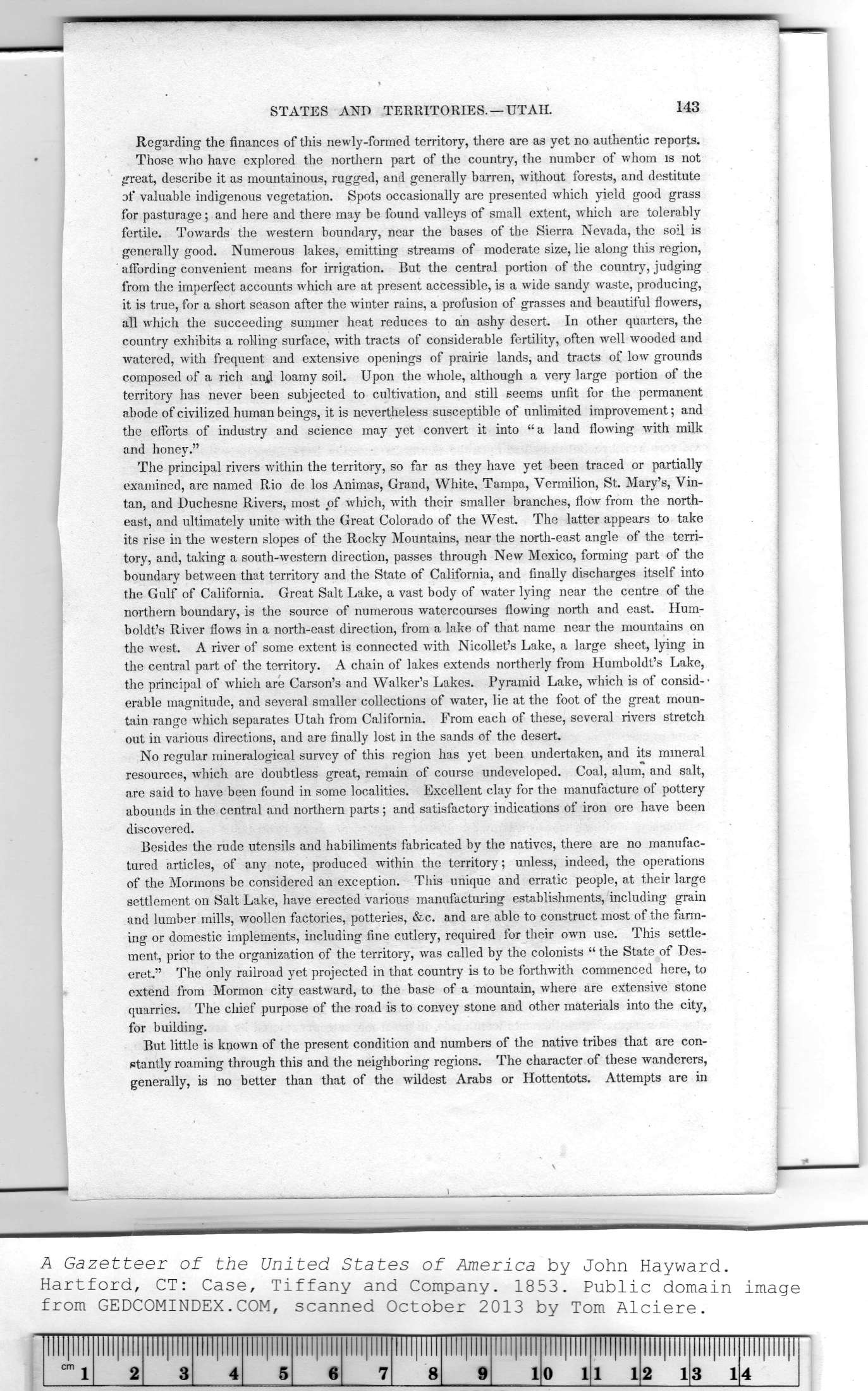|
|
Note: Ctrl and + increases the font size of the text below, Ctrl and - decreases it, and Ctrl and 0 resets it to default size.
STATES AND TERRITORIES. —UTAH. 143
Regarding the finances of this newly-formed territory, there are as yet no authentic reports.
Those who have explored the northern part of the country, the number of whom is not
great, describe it as mountainous, rugged, and generally barren, without forests, and destitute
of valuable indigenous vegetation. Spots occasionally are presented which yield good grass
for pasturage; and here and there may be found valleys of small extent, which are tolerably
fertile. Towards the western boundary, near the bases of the Sierra Nevada, the soil is
generally good. Numerous lakes, emitting streams of moderate size, lie along this region,
affording convenient means for irrigation. But the central portion of the country, judging
from the imperfect accounts which are at present accessible, is a wide sandy waste, producing,
it is true, for a short season after the winter rains, a profusion of grasses and beautiful flowers,
all which the succeeding summer heat reduces to an ashy desert. In other quarters, the
country exhibits a rolling surface, with tracts of considerable fertility, often well wooded and
watered, with frequent and extensive openings of prairie lands, and tracts of low grounds
composed of a rich and loamy soil. Upon the whole, although a very large poi'tion of the
territory has never been subjected to cultivation, and still seems unfit for the permanent
abode of civilized human beings, it is nevertheless susceptible of unlimited improvement; and
the efforts of industry and science may yet convert it into “a land flowing with milk
and honey."
The principal rivers within the territory, so far as they have yet been traced or partially
examined, are named Rio de los Animas, Grand, White, Tampa, Vermilion, St. Mary's, Vin-
tan, and Duchesne Rivers, most of which, with their smaller branches, flow from the north-
east, and ultimately unite with the Great Colorado of the West. The latter appears to take
its rise in the western slopes of the Rocky Mountains, near the north-east angle of the terri-
tory, and, taking a south-western direction, passes through New Mexico, forming part of the
boundary between that territory and the State of California, and finally discharges itself into
the Gulf of California. Great Salt Lake, a vast body of Avater lying near the centre of the
northern boundary, is the source of numerous watercourses flowing north and east. Hum-
boldt's River Aoavs in a north-east direction, from a lake of that name near the mountains on
the Avest. A river of some extent is connected with Nicollet's Lake, a large sheet, lying in
the central part of the territory. A chain of lakes extends northerly from Humboldt's Lake,
the principal of Avhich are Carson's and Walker's Lakes. Pyramid Lake, Avhich is of consid- •
erable magnitude, and several smaller collections of water, lie at the foot of the great moun-
tain range which separates Utah from California. From each of these, several rivers stretch
out in various directions, and are finally lost in the sands of the desert.
No regular mineralogical survey of this region has yet been undertaken, and its mineral
resources, Avhich are doubtless great, remain of course undeveloped. Coal, alum, and salt,
are said to have been found in some localities. Excellent clay for the manufacture of pottery
abounds in the central and northern parts; and satisfactory indications of iron ore have been
discovered.
Besides the rude utensils and habiliments fabricated by the natives, there are no manufac-
tured articles, of any note, produced Avithin the territory; unless, indeed, the operations
of the Mormons be considered an exception. This unique and erratic people, at their large
settlement on Salt Lake, have erected various manufacturing establishments, including grain
and lumber mills, woollen factories, potteries, &c. and are able to construct most of the farm-
ing or domestic implements, including fine cutlery, required for their own use. This settle-
ment, prior to the organization of the territory, Avas called by the colonists “ the State of Des-
eret." The only railroad yet projected in that country is to be forthAvith commenced here, to
extend from Mormon city eastAvard, to the base of a mountain, where are extensive stone
quarries. The chief purpose of the road is to convey stone and other materials into the city,
for building.
But little is known of the present condition and numbers of the native tribes that are con-
stantly roaming through this and the neighboring regions. The character of these wanderers,
generally, is no better than that of the wildest Arabs or Hottentots. Attempts are in
|
Illllllll |
Illllllll |
Illllllll |
Illllllll |
llll|llll |
Illllllll |
llll|llll |
|
Illllllll |
Illllllll |
Illllllll |
Illllllll |
Illllllll |
Illllllll |
llll|llll|l |
|
cm ^ |
2 |
3 |
4 |
5 |
6 |
7 |
8 |
9 |
1 |
0 1 |
1 1 |
2 1 |
3 1 |
4 |
|
